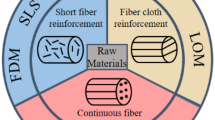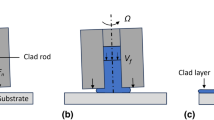Abstract
The flat clinching process is attracting a growing attention in the joining field of lightweight materials because it avoids the geometric protrusion that appears in the conventional clinching process. In this paper, the effects of sheet thickness and material on the mechanical properties of the clinched joint were studied. Al1060 and Al2024 sheets with 2 mm thickness were employed to develop the clinched joint by using different material configurations, and Al1060 sheets with 2.5- and 1.5-mm thicknesses were used to produce the clinched joint by using different thickness configurations. The clinched joints using various sheet configurations were sectioned, and dimensional analysis was conducted. Cross-tensile and shearing tests were carried out to analyze the mechanical properties of the clinched joint, including tensile strength, shearing strength, and absorbed energy. In addition, the failure modes of the clinched joints were discussed. Results indicated that the clinched joint with a stiff top sheet had increased static strength regardless of the test type. The clinched joint with a thick top sheet demonstrated lower static strength than the joint with a thick bottom sheet in the cross-tensile test. However, this result was reversed in the shearing tests. The flat clinching process has a great potential in joining dissimilar and various thickness materials.
Similar content being viewed by others
References
Lambiase F. Influence of process parameters in mechanical clinching with extensible dies. International Journal of Advanced Manufacturing Technology, 2013, 66(9–12): 2123–2131
Song Y, Yang L, Zhu G, et al. Numerical and experimental study on failure behavior of steel-aluminium mechanical clinched joints under multiple test conditions. International Journal of Lightweight Materials and Manufacture, 2019, 2(1): 72–79
Lei L, He X, Yu T, et al. Failure modes of mechanical clinching in metal sheet materials. Thin-Walled Structures, 2019, 144: 106281
Chu M, He X, Zhang J, et al. Clinching of similar and dissimilar sheet materials of galvanized steel, aluminium alloy and titanium alloy. Materials Transactions, 2018, 59(4): 694–697
Lee C J, Kim J Y, Lee S K, et al. Parametric study on mechanical clinching process for joining aluminum alloy and high-strength steel sheets. Journal of Mechanical Science and Technology, 2010, 24(1): 123–126
Tenorio M B, Lajarin S F, Gipiela M L, et al. The influence of tool geometry and process parameters on joined sheets by clinching. Journal of the Brazilian Society of Mechanical Sciences and Engineering, 2019, 41(2): 67
Lambiase F, Di Ilio A. An experimental study on clinched joints realized with different dies. Thin-Walled Structures, 2014, 85: 71–80
Abe Y, Kato T, Mori K I, et al. Mechanical clinching of ultra-high strength steel sheets and strength of joints. Journal of Materials Processing Technology, 2014, 214(10): 2112–2118
Mucha J, Kaščák L, Spišák E. Joining the car-body sheets using clinching process with various thickness and mechanical property arrangements. Archives of Civil and Mechanical Engineering, 2011, 11(1): 135–148
Abe Y, Saito T, Mori K I, et al. Mechanical clinching with dies for control of metal flow of ultra-high-strength steel and high-strength steel sheets. Proceedings of the Institution of Mechanical Engineers, Part B: Journal of Engineering Manufacture, 2018, 232(4): 644–649
Varis J P. The suitability of round clinching tools for high strength structural steel. Thin-Walled Structures, 2002, 40(3): 225–238
Lambiase F. Mechanical behaviour of polymer-metal hybrid joints produced by clinching using different tools. Materials & Design, 2015, 87: 606–618
Lambiase F, Di Ilio A. Optimization of the clinching tools by means of integrated FE modeling and artificial intelligence techniques. Procedia CIRP, 2013, 12: 163–168
Hamel V, Roelandt J, Gacel J, et al. Finite element modeling of clinch forming with automatic remeshing. Computers & Structures, 2000, 77(2): 185–200
Lambiase F. Joinability of different thermoplastic polymers with aluminium AA6082 sheets by mechanical clinching. International Journal of Advanced Manufacturing Technology, 2015, 80(9–12): 1995–2006
Abe Y, Mori K, Kato T. Joining of high strength steel and aluminium alloy sheets by mechanical clinching with dies for control of metal flow. Journal of Materials Processing Technology, 2012, 212(4): 884–889
Neugebauer R, Kraus C, Dietrich S. Advances in mechanical joining of magnesium. CIRP Annals, 2008, 57(1): 283–286
Kaðèák L, Spiðák E, Kubík R, et al. Finite element calculation of clinching with rigid die of three steel sheets. Strength of Materials, 2017, 49(4): 488–499
Kaščák L, Mucha J, Spisak E, et al. Wear study of mechanical clinching dies during joining of advanced high-strength steel sheets. Strength of Materials, 2017, 49(5): 726–737
Sabra Atia M K, Jain M K. A parametric study of FE modeling of die-less clinching of AA7075 aluminum sheets. Thin-Walled Structures, 2018, 132: 717–728
Atia M K S, Jain M K. Finite element analysis of material flow in die-less clinching process and joint strength assessment. Thin-Walled Structures, 2018, 127: 500–515
Gerstmann T, Awiszus B. Recent developments in flat-clinching. Computational Materials Science, 2014, 81: 39–44
Lüder S, Härtel S, Binotsch C, et al. Influence of the moisture content on flat-clinch connection of wood materials and aluminium. Journal of Materials Processing Technology, 2014, 214(10): 2069–2074
Han X, Zhao S, Chen C, et al. Optimization of geometrical design of clinching tools in flat-clinching. Journal of Mechanical Engineering Science, 2017, 231(21): 4012–4021
Chen C, Zhao S, Han X, et al. Experimental investigation on the joining of aluminum alloy sheets using improved clinching process. Materials, 2017, 10(8): 887
Chen C, Zhao S, Han X, et al. Investigation of flat clinching process combined with material forming technology for aluminum alloy. Materials, 2017, 10(12): 1433
Varis J P. The suitability of clinching as a joining method for high-strength structural steel. Journal of Materials Processing Technology, 2003, 132(1–3): 242–249
Chen C, Zhao S, Han X, et al. Experimental investigation of the mechanical reshaping process for joining aluminum alloy sheets with different thicknesses. Journal of Manufacturing Processes, 2017, 26: 105–112
Chen C, Han X, Zhao S, et al. Influence of sheet thickness on mechanical clinch-compress joining technology. Journal of Process Mechanical Engineering, 2018, 232(6): 662–673
He X, Zhang Y, Xing B, et al. Mechanical properties of extensible die clinched joints in titanium sheet materials. Materials & Design, 2015, 71: 26–35
Chen C, Han X, Zhao S, et al. Comparative study on two compressing methods of clinched joints with dissimilar aluminum alloy sheets. International Journal of Advanced Manufacturing Technology, 2017, 93(5–8): 1929–1937
Eshtayeh M M, Hrairi M. Recent and future development of the application of finite element analysis in clinching process. International Journal of Advanced Manufacturing Technology, 2016, 84(9–12): 2589–2608
de Paula A A, Aguilar M T P, Pertence A E M, et al. Finite element simulations of the clinch joining of metallic sheets. Journal of Materials Processing Technology, 2007, 182(1–3): 352–357
Mucha J. The analysis of lock forming mechanism in the clinching joint. Materials & Design, 2011, 32(10): 4943–4954
Pietrapertosa C, Zhang L, Habraken A, et al. Clinching joining system: Validation of numerical models. In: Proceedings of the 6th International ESAFORM Conference on Material Forming. Salerno: Nuova Ipsa editire, 2003, 351–354
Xu F, Zhao S, Han X. Use of a modified Gurson model for the failure behaviour of the clinched joint on Al6061 sheet. Structures Fracture of Engineering Materials, 2014, 37(3): 335–348
Zhao S, Xu F, Guo J, et al. Experimental and numerical research for the failure behavior of the clinched joint using modified Rousselier model. Journal of Materials Processing Technology, 2014, 214(10): 2134–2145
He X, Zhao L, Yang H, et al. Investigations of strength and energy absorption of clinched joints. Computational Materials Science, 2014, 94: 58–65
Lei L, He X, Zhao D, et al. Clinch-bonded hybrid joining for similar and dissimilar copper alloy, aluminium alloy and galvanised steel sheets. Thin-Walled Structures, 2018, 131: 393–403
Acknowledgements
This research work was supported by the National Natural Science Foundation of China (Grant No. 51805416), the Young Elite Scientists Sponsorship Program by CAST, the Natural Science Foundation of Hunan Province, China (Grant No. 2020JJ5716), the Natural Science Basic Research Plan in Shaanxi Province of China (Grant No. 2019JQ-372), the Research Fund of State Key Laboratory of High Performance Complex Manufacturing (Grant No. ZZYJKT2019-01), and the Huxiang High-Level Talent Gathering Project of Hunan Province, China (Grant No. 2019RS1002).
Author information
Authors and Affiliations
Corresponding author
Rights and permissions
About this article
Cite this article
Chen, C., Zhang, H., Zhao, S. et al. Effects of sheet thickness and material on the mechanical properties of flat clinched joint. Front. Mech. Eng. 16, 410–419 (2021). https://doi.org/10.1007/s11465-020-0618-y
Received:
Accepted:
Published:
Issue Date:
DOI: https://doi.org/10.1007/s11465-020-0618-y




